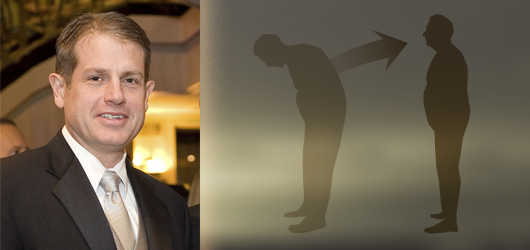
Illustration by Martha Headworth / Mayfield Clinic.
Even when you “stand up straight!” as your mother commanded, you still have a curve to the spine. This is normal. The normal spine, which Mayfield neurosurgeon Charles Kuntz, IV, MD, has studied extensively, has multiple curves. Looking at the spine from the side, the column of vertebrae curves gently toward your chin in the cervical (neck) region, curves outward in the thoracic (chest) region, and curves inward toward your waist in the lumbar region. As we age, these curves will naturally change.
But for a small number of people, spinal curves can become extreme as a result of an injury, age or spinal degeneration. These patients suffer from spinal deformity, and when they come to visit Dr. Kuntz at Mayfield, the experience can be life-changing and transformative.“When I think about spinal deformity surgery I think about changing lives,” Dr. Kuntz says. “I’m passionate about what I do, because you know you can transform and revolutionize a person’s life.”
Dr. Kuntz has treated patients whose spinal deformity was so severe that their chin was affixed to their chest; they couldn’t stand for more than a few minutes; or they couldn’t physically look straight ahead. In such cases, Dr. Kuntz says, the patient may have difficulty eating or breathing, may be unable to work, and may have begun to withdraw from friends and community.
Medical names for these conditions include significant scoliotic, kyphotic, and scoliokyphotic deformity. Many studies have shown that surgery is superior to physical therapy and epidural steroid injections for adult deformity.
Spinal deformity surgery is often done in two or three stages over a period of days. “It is a big procedure,” Dr. Kuntz says. “We may need to make a long incision and take wedges of bone out of the spine or possibly put rods in and crack the spine; you may actually hear a pop when you do this in the operating room.”
The procedure carries the risk of paralysis, but the benefits are revolutionary. “We ask a patient to accept a significant risk for a significant gain,” Dr. Kuntz says. “The patient may be living in misery and isolation. If the patient is able to accept the risk, he or she can basically be returned to normal or near-normal spinal alignment. No matter what outcome measure you use – the outcomes are dramatic.”
— Cindy Starr